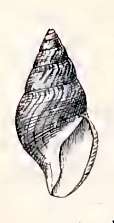Gymnobela frielei
Gymnobela frielei is a species of sea snail, a marine gastropod mollusk in the family Raphitomidae.[1]
| Gymnobela frielei | |
|---|---|
 | |
| Original image of a shell of Gymnobela frielei | |
| Scientific classification | |
| Kingdom: | Animalia |
| Phylum: | Mollusca |
| Class: | Gastropoda |
| Clade: | Caenogastropoda |
| Clade: | Hypsogastropoda |
| Clade: | Neogastropoda |
| Superfamily: | Conoidea |
| Family: | Raphitomidae |
| Genus: | Gymnobela |
| Species: | G. frielei |
| Binomial name | |
| Gymnobela frielei (Verrill, 1885) | |
| Synonyms[1] | |
| |
Description
The length of the shell attains 30 mm, its diameter 10 mm.
(Original description) The shell is of moderate size, rather thick and solid, elongate-ovate or subfusiform,. It shows a rather long, regularly tapered spire, consisting of about six whorls below the protoconch, which is small and consists of two or more whorls, eroded in our specimens. The whorls of the spire are a little convex and slightly angulated or shouldered just above the middle, and have a rather broad, slightly concave subsutural band. The body whorl is more evenly convex and the shoulder is rounded and rather indistinct. The surface is covered with numerous rather fine, flexuous riblets, parallel with the lines of growth. These curve forward on the middle of the whorl below the shoulder, but are strongly excurved in crossing the subsutural band, and become thin and more prominent just below the suture, which is distinctly impressed. The surface is also covered with very numerous thin, revolving cinguli, which are separated by intervals of about the same width. These extend over the subsutural band, but are there a little less prominent. On the convex part of the whorls they are wavy and irregularly decussated by the lines of growth. On the spire the two sets of lines produce a cancellated structure. The aperture is short and rather [broad, with an acute angle posteriorly and a short, broad, straight siphonal canal in front. The columella is short, nearly straight, with the inner edge strongly sinuous and obliquely cut away at the end. The inner lip is strongly excavated at the base of the columella. The outer lip is regularly curved, except above the shoulder, where it is slightly flattened and sloping. In the middle it projects considerably forward in a broad curve, but the posterior sinus is broad, rather deep, well-rounded, and deepest just above the shoulder. The color of the shell is grayish or yellowish white externally, bluish white within. One specimen shows a conspicuous reddish brown patch on the columella margin.[2]
Distribution
This marine species occurs off New Jersey, USA and the Azores.
References
- Gymnobela frielei (Verrill, 1885). Retrieved through: World Register of Marine Species on 29 March 2010.
- Verrill A. E. (1885). Third catalogue of mollusca recently added to the fauna of the New England Coast and the adjacent parts of the Atlantic, consisting mostly of deep sea species, with notes on others previously recorded. Transactions of the Connecticut Academy of Arts and Sciences, 6: 395–452, pl. 42-44

- Sysoev A.V. (2014). Deep-sea fauna of European seas: An annotated species check-list of benthic invertebrates living deeper than 2000 m in the seas bordering Europe. Gastropoda. Invertebrate Zoology. Vol.11. No.1: 134–155
- Gofas, S.; Le Renard, J.; Bouchet, P. (2001). Mollusca. in: Costello, M.J. et al. (eds), European Register of Marine Species: a check-list of the marine species in Europe and a bibliography of guides to their identification. Patrimoines Naturels. 50: 180–213
External links
- Dautzenberg P. & Fischer H. (1896). Dragages effectués par l'Hirondelle et par la Princesse Alice 1888–1895. 1. Mollusques Gastéropodes. Mémoires de la Société Zoologique de France. 395–498, pl. 15-22
- Locard A. (1897–1898). Expéditions scientifiques du Travailleur et du Talisman pendant les années 1880, 1881, 1882 et 1883. Mollusques testacés. Paris, Masson. vol. 1 [1897], p. 1–516 pl. 1-22; vol. 2 [1898], p. 1–515, pl. 1-18
- Tucker, J.K. (2004). "Catalog of recent and fossil turrids (Mollusca: Gastropoda)" (PDF). Zootaxa. 682: 1–1295.
- Bouchet & Warren, Revision of the North-East Atlantic bathyal and abyssal Turridae (Mollusca, Gastropoda); The Journal of Molluscan Studies, supplement 8, December 1980